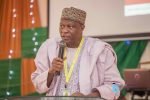Osun: How The Media Under-developed Nigeria


Content analyze the headline grabbers of Rauf Aregbesola’s gubernatorial years (2010-2018), and you can glean how news reportage under-develops the polity.
If you focus on sensations and titillations, to the detriment of core developmental news, you are not only subverting a government striving to attain the Jeremy Bentham model of the greatest happiness of the greatest number, you are also frustrating a putative governmental model that could lift millions of other Nigerians, from their misery.
That would appear an objective appraisal of the media coverage of the Aregbesola years.
Top news headlines, impassioned analyses and even thunderous editorials, framed almost exclusively elite pastimes — Osun’s reported debt burden, salary delays, alleged attempts at “Islamization”, and “secession”, etc.
Salary delays and worries over a putative debt overhang are earnest and serious, for a media doing its watch dog role. But charges of “Islamization” and “secession” are clearly ludicrous.
On the balance, however, the media, earnest or complicit, just weighed in, on Osun elite pitched battles, which had little or nothing to do with the wellness of the greatest number. That was distraction from the core essentials.
Yet, the fundamental pillar of governance is catering for the overwhelming interest of the vast majority. That is where the government earns its legitimacy. Besides, the 1999 Constitution stipulates some fundamental principles of state policy, which are people-skewed.
The latest proof, of this media fixation with shadows, instead of developmental substance, is a three-year study, which the Federal Ministry of Health (FMH) just released, on a project it calls Saving One Million Lives Programme for Results (SOML-PforR).
SOML-PforR is the code for six discrete indicators, gauging the performance of the 36 states and the Federal Capital Territory of Abuja, from 2015 to 2018, on maternal and child health service delivery.
A casual glance at the 2018 survey returns shattering results, on a core human development front: only 12 states out of 36 (a third) and FCT passed the muster.
That means only a third of the states have been addressing human capital development at perhaps its most critical juncture: maternal and child health. That is where it all starts — and could also end — for the poor and the vulnerable, who are in the vast majority.
Poor maternal and child health services, which may signal the end for the poor, introduce another demographic bomb.
The poor (not the rich or even the middle class) mainly patronize public hospitals, which FMH and state ministries of Health run.
Yet, two out of three state governments in Nigeria have, at least in maternal and child health, shunned that majority. It’s yet another proof of a general elite indulgence, and neglect of the poor, in Nigerian governance.
But it’s in this rare and consistently better deal for the poor majority that the Aregbesola government posted a refreshing difference, over eight years. But it’s that same core developmental area, that the media virtually blacked out. That beggars its watch dog role.
In this SOML-PforR survey, Osun with an improvement rate of 97.4 per cent, came only next to Yobe (133.4 per cent).
Other states with improved performance are Borno (63.5 per cent), Kano (35.2 per cent), Nasarawa (33.6 per cent), Adamawa (29 per cent), Niger (26.8 per cent), Jigawa (21.9 per cent), Taraba (13.5 per cent), Gombe (nine per cent), Ondo (6.4 per cent) and Zamfara (1.3 per cent). The FCT (42.6 per cent) makes up the number — and just as well, for it shows the FMH, which powers the survey, at least walks its talk; but not as much as Yobe and Osun!
Another surprise is that most states that achieved improvements are in the North, supposedly the less developed in the Nigerian territory.
Indeed, only Osun and Ondo bucked the parlous survey results by the southern states. Still, the southern media point fingers and thunder at others, while their own uppity states lag behind in this crucial area. Another proof of distraction, wilful or ernest?
No state, South East or South-South, even with South-South’s oil wealth, made this leap. Yet, these are comparatively wealthier states, than their northern counterparts. So, why do their poor languish in health neglect?
But again, this is where Osun, under Aregbesola, sparkled. That is even more glaring, when you contrast the Osun survey results, with the rest of the states in the South West.
Mighty Lagos, richest and most vibrant, posted a -14.3 per cent decline — perhaps because of intense population pressure on its facilities? Ogun: -29.9 per cent; Oyo: -0.2 per cent; Ondo: 6.4 per cent and Ekiti: -19.6 per cent.
Apart from Ekiti, Osun is the poorest of the South West states, both on allocation from the Federation Account and internally generated revenue (IGR). Lagos is the richest. Yet, from this survey, Osun despite its poor purse, is splashing more resources on the poor and the society’s most vulnerable (97.4 per cent); far better than super-rich Lagos (-14.3 per cent)! But Lagos, even with all of its population pressure, still out-performed Ogun (-29.9 per cent) which, linked to its population, is not exactly poor.
Still, the general lesson is for the other South West states to follow the Osun example: spend more on critical facilities concerning the poor, who have nobody else to turn to.
If Lagos and Ogun follow this template, the region would be far better off, in human development capital; and a post-Ayo Fayose Ekiti, under Kayode Fayemi, would be encouraged to tread that path too, as Dr. Fayemi did during his first term.
But Osun’s survey strides are only the latest of a slew of others, development achievement that ought to have been showcased as model for others, but mostly snubbed by the media, over an eight-year period.
Local economic gauging agencies like the National Bureau of Statistics (NBS) and Financial Derivatives Company Limited in Lagos; and international development agencies: the Oxford Poverty and Human Development Institute (OPHDI) and the United Nations Development Programme (UNDP), have consistently returned a positive growth and development results, over Aregbesola’s eight-year tenure as governor, and affirmed the success of its anti-poverty programmes.
Between 2010 and 2018, Osun’s GDP grew by 108.3 per cent, from N191.1 billion (2010) to N398 billion (2018). During this same period, small and medium enterprises (SMEs) almost trebled (182 per cent), from 481, 451 (in 2010) to 1, 358, 446 (in 2018).
That showed an Osun economy expanding beyond a “civil service state”, a euphemism for economic stagnancy and perpetual under-development. Much of the SME growth had been fuelled by better infrastructure, particularly in ambitious roads and bridges, that fasten mobility and shorten business time. By the way, that improved economic activity posted a much improved IGR: from N3.4 billion in 2010 to N14 billion (in 2018) — a more than 400 per cent leap.
In a period of economic adversity (as it was from 2012 to 2010), much of the infrastructure would have to be funded by loans, since the state had no cash of its own anyway but had no choice but to jumpstart the economy, to escape being a perpetual economic laggard.
Yet, the media howled and screeched at Osun’s “mounting debts”; but stayed blind, deaf and dumb to what use those debts had been put into, and their multiplier effects on the rebounding Osun economy.
But the SME growth, fuelled by more modern support infrastructure, don’t even tell the whole story. A crucial part of that is the Osun Youth Employment Scheme (O’YES) volunteer programme, with its N10, 000 monthly stipends.
O’YES trainees, drilled in many entrepreneurial skills, account for the rash of business start-ups, which boosted the growth of SMEs between 2010 and 2018.
That not only took many skilled youths from paid (and government employment in a “civil service state”), it also provided a model the World Bank is pushing to many states — and even countries — to tackle their local youth unemployment challenges. Incidentally, even the Federal Government has used O’YES as a model to power its own N-Power youth volunteer job scheme.
But neither did all these too tell the complete story. Complementing O’YES for skilled youths and young graduates, is the schools feeding programme, for children in grades 1-4 in public primary schools, the Aregbesola government dubbed O’Meals (Osun Meals).
After good investments in maternal and child health, feeding children in the lowest rungs of public school appears a logical follow-up. Under this scheme, in six short years (2012-2018), N10 billion was spent to feed 1.5 million pupils, in 1, 382 public elementary schools. That came down to 305 million plates of food!
Now, add that to rash of new schools, upgrade of old ones, progressive improvement of learning environment in public schools, fortified with better learning tools like Opon Imo (Learning computer tablets storing all recommended texts and other learning aids) over the years, and you see a deliberate and direct investment, to ensure a better and more productive picture, for the poor and vulnerable majority.
That is what, as routine, governance ought to be. That Osun ought to be a model to others, in what ought to be the norm, just shows how wide governments in Nigeria have veered from their core pristine duties.
Flashed back to the most ancient of days, the Osun paradigm, under Aregbesola, bore an uncanny resemblance to Sparta, the Greek city state, that tracked, consistently, the welfare and wellbeing of its citizens, from cradle to grave.
That explained the fierce Spartan patriotism, which manifested in the glorious tragedy of King Leonidas and his famous 300 troops, at the pass of Thermopylae in 480 BC, that fought and dropped to the last man, instead of capitulating to shameful surrender.
Which is why, the media snub, innocent or wilful, of this pro-poor model, is even more tragic.
Instead of beaming the searchlight on these developmental strides, in a period of dire economic adversity, much of the media got fixated with the salary crisis.
They not only made Aregbesola a scapegoat for a pan-Nigeria crisis, that skew also robbed other governments the benefit of tapping into the Osun success, to solve similar problems, in their own states.
Prompt payment of salaries is a right. Even the Bible says the labourer has a right to prompt pay, even before the sweat of his labour dries off. So, the problem was not agitating for prompt pay.
It was rather skewing it as the sole index to judge a state striving to expand its economy, ironically to make those same salaries a mere routine.
It was a classic in the misplacement of media priorities; and a wanton skewing of the media space towards elite problems — no matter how pressing or legitimate — to the detriment of the majority. Civil servants are seldom up to 15 per cent of any state’s population.
The media mis-coverage of the Aregbesola governorship should teach the different lobbies, different lessons.
The media must focus on what matter and shun inanities. The reverse was the case in covering Aregbesola’s Osun.
Governments must re-discover their purpose — to make a difference in the lives of the teeming majority. That is where they draw their legitimacy; and how they can justify their existence. For that, the Osun policy, from 2010 to 2017, is a good reference point.
New Osun Governor, Gboyega Oyetola, Aregbesola’s chief of staff, for most of his tenure, must learn from Aregbesola’s mistakes. But he must also fiercely focus on his development agenda, no matter the media distractions.
That is the only way the Osun poor and vulnerable majority can continue to secure better deals from their government, with a media so fixated with the elite agenda.
That is the only way Oyetola can secure his own legacies and cement his government’s own place in history.








